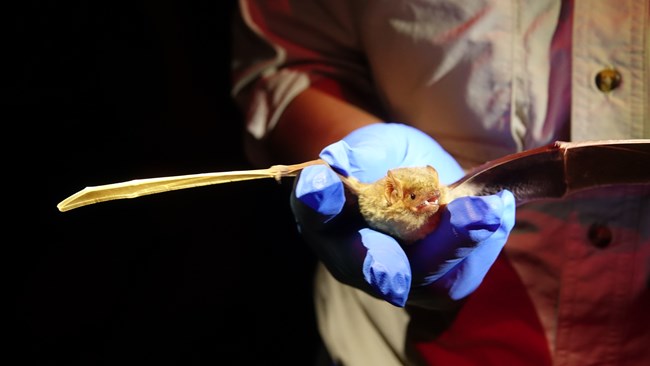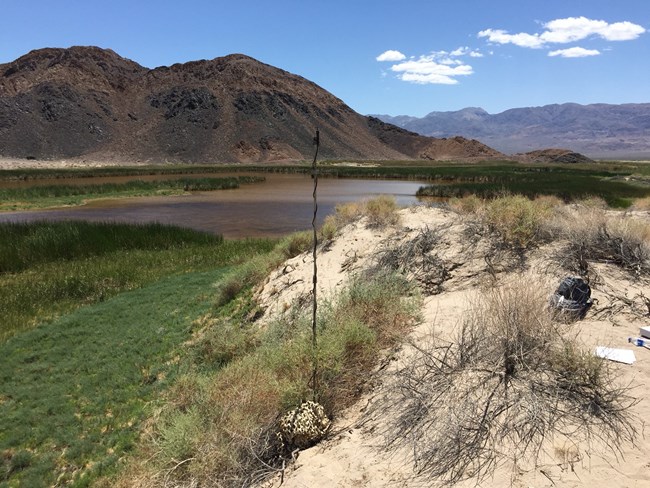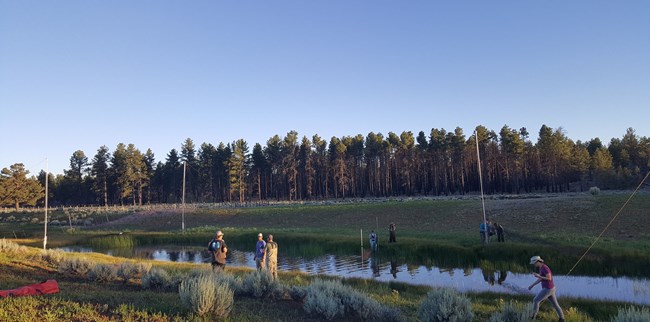
NPS photo
Pilot Bat Monitoring Plan
Why study bats?
Millions of bats of over 50 different species live in national parks! They pollinate, eat insects, use echolocation, and fascinate visitors. Some migrate, and some hibernate. Each species is unique, but they face many of the same threats: wind energy development, habitat loss, climate change, and white-nose syndrome (WNS). White-nose syndrome is the primary focus of the Mojave Desert Network’s bat monitoring efforts.
White-nose syndrome is a fatal disease in bats caused by the fungus Pseudogymnoascus destructans. The disease affects cave-dwelling bats by growing on their face and wings while they hibernate. This causes them to come out of hibernation too often during the winter, using up valuable fat reserves. Most of them die of starvation before spring. Researchers first discovered the disease in New York in the winter of 2006. Since then, it has spread to more than half of the United States, killing millions of bats and nearly wiping out entire bat colonies. While the fungus has not been detected within the Mojave Desert I&M Network, it has spread to northern California and is a cause for concern across the region.
Overview
Mojave Desert I&M Network is spearheading a monitoring program to proactively collect baseline bat data within network parks. These data will contribute to an understanding of how bat species richness and activity levels change over time, and will inform park management decisions as WNS continues to spread. The monitoring program involves close coordination with staff at each park and includes three different avenues to monitor bats:

NPS photo
Acoustic Surveys
We are following a modified version of the North American Bat Monitoring Program (NABat). NABat uses acoustic bat detectors to inventory our bats. These detectors work by recording the echolocation calls of bats as they fly past a microphone. Bats are then identified to species by the unique acoustic signature of their call. The detectors are placed in sites where bats are likely to be found, such as areas with open drinkable water or at desert springs where the vegetation attracts insects. We also monitor hydrology and vegetation at many of the same sites.
WNS Surveillance Surveys
WNS surveillance surveys are done by capturing bats in each park and rolling a cotton swab across their face, body, and wings. The cotton swabs pick up samples of fur and skin, which are shipped to a lab where they are processed to determine if the fungus that causes WNS is present. This is currently the most effective method of determining if the fungus has arrived in a new location.

NPS
Network Bat Blitzes
A bat blitz is a coordinated event where a large number (20) of NPS and other agency staff work together to collect as much bat data as possible in one location over just a few days. These blitzes provide a snapshot of bat species presence across a park using acoustic and capture methods. They also provide excellent training for park staff who may not have any access to training in bat monitoring methods, increasing our capacity to monitor bats across the network. We produce resource briefs for the blitzes at each park - short documents that highlight the methods used, the species observed, and what we learned.
Monitoring objectives
- Determine baseline species richness at network parks
- Determine trends in species richness over time
- Determine trends in species activity levels over time
- Provide data to the larger scale NABat program
Source: NPS DataStore Collection 7982. To search for additional information, visit the NPS DataStore.
Learn More about Bat Conservation and Monitoring
Reports and Publications
Monitoring protocols describe why and how we collect, manage, analyze, and report monitoring data about the network's monitoring programs.
Monitoring reports, as they are developed, will summarize data and findings from our monitoring activities and will also be available here.
Monitoring Protocol
The NABat monitoring protocol document is available here. In the future, the network plans to develop a protocol implementation plan based on the recently published NABat regional protocol for the Pacific Northwest (complete NABat protocol package, including standard operating procedures, available here).
Monitoring Reports
Coming soon!
Last updated: September 30, 2025
